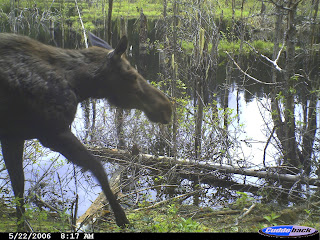On Saturday, I visited the marshy pond on upper Glenrosa
Road, the one that lies just at the junction with Jackpine Forest Service Road.
I have a trail camera there which monitors a shoreline that is frequented by
moose. My camera had stored four pictures of visits by two moose, a cow and
her yearling calf.
The calf is smaller than I would
have expected at this season. Perhaps it was born unusually late last spring.
This pond is fed by seepage from the side nearest
Jackpine Road, which is the shoulder of Mount Swite. Herb will remember our
brief foray into that area during the period of deep snow last winter. We had
visions of enjoying a snowshoe trek across the pond. It seemed solidly frozen
and I stepped out boldly--right through the snow and into water! Under the
snow, springs were keeping that edge of
the pond ice-free. I found that snowshoes are not suitable for walking on
water.
Last summer, I had found that the seepage area on the
hillside supports some interesting plants that are not as common in the
generally drier surrounding area; Indian Hellebore, striking because of its
large size and Clasping Twisted Stalk,
The Hellebore (broad-leaved plant to the right of Twisted Stalk) will grow rapidly, until it reaches heights of two to three metres.
Clasping Twisted Stalk (as viewed from below).
Foamflower, Pink
Wintergreen and Dwarf Dogwood (Bunchberry) also thrive there, as well as a rich
mix of ferns and mosses.
Foamflower
Pink Wintergreen
It is an area that I want to explore further. The pond is a valuable breeding
area for the endangered Western Toad and there are muskrats there, at least I
saw several there last summer.
There is a variety of wildflowers on and near the road embankment, such as Arctic Lupine ----
and Largeleaf Avens.








No comments:
Post a Comment